Comprehensive Financial Analysis and Performance of Virgin Atlantic
VerifiedAdded on 2023/02/07
|15
|3811
|47
Report
AI Summary
This report provides a comprehensive financial analysis of Virgin Atlantic, examining its performance from 2018 to 2022. It includes an executive summary, financial ratio analysis (liquidity, efficiency, profitability, and long-term stability), an evaluation of the airline industry sector, a SWOT analysis of Virgin Atlantic, and share valuation considerations. The report also explores financial and non-financial factors impacting valuation, suitable governance structures, and concludes with key findings. The analysis compares Virgin Atlantic's performance with competitors like Ryan Air, British Airways, and Jet 2 PLC, providing a detailed assessment of its strengths, weaknesses, opportunities, and threats. The financial ratios are analyzed across the five-year period, and industry benchmarks are included for comparison. The report further investigates the implications of the company's financial health, including its current and future obligations and stability, offering a detailed understanding of the airline's financial position and strategic considerations.
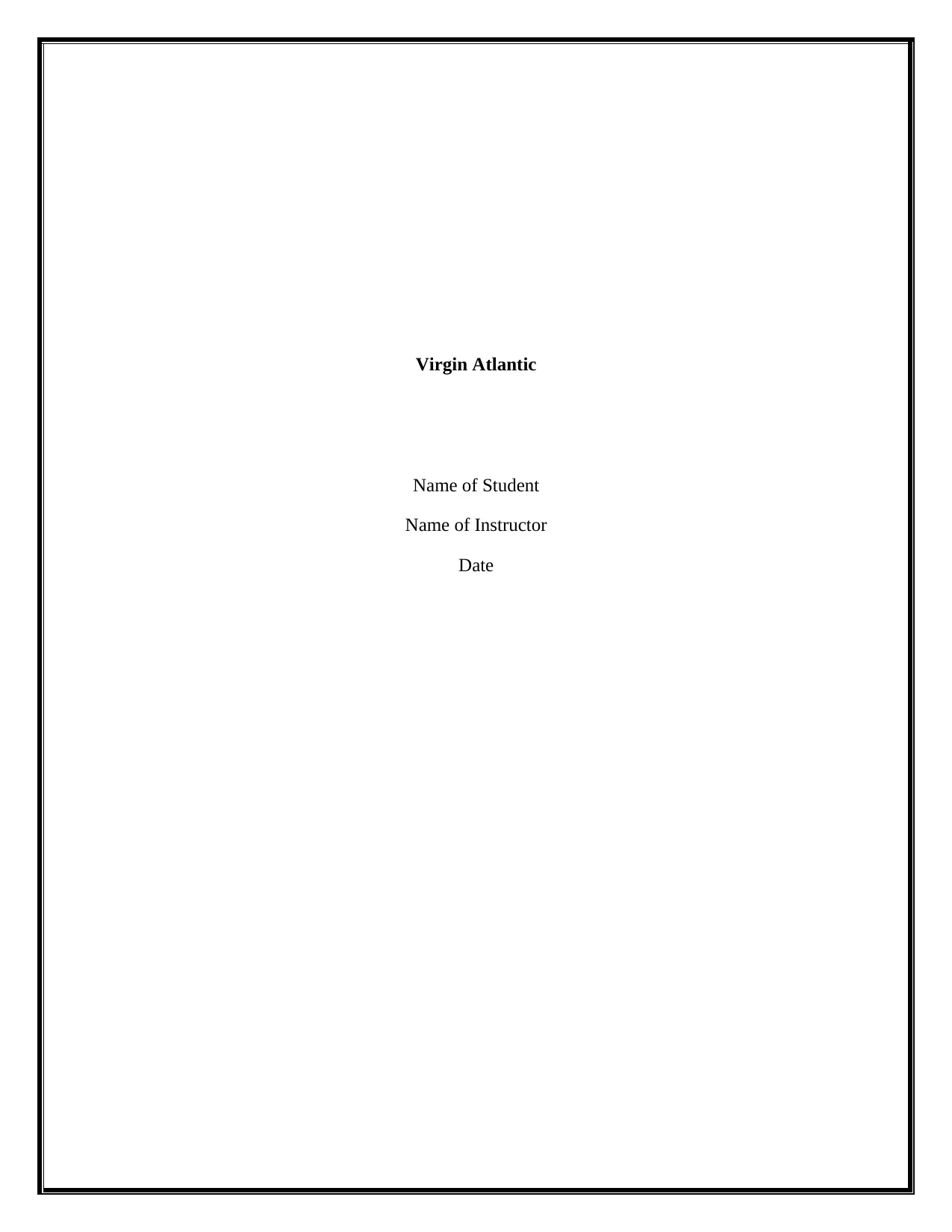
Virgin Atlantic
Name of Student
Name of Instructor
Date
Name of Student
Name of Instructor
Date
Paraphrase This Document
Need a fresh take? Get an instant paraphrase of this document with our AI Paraphraser
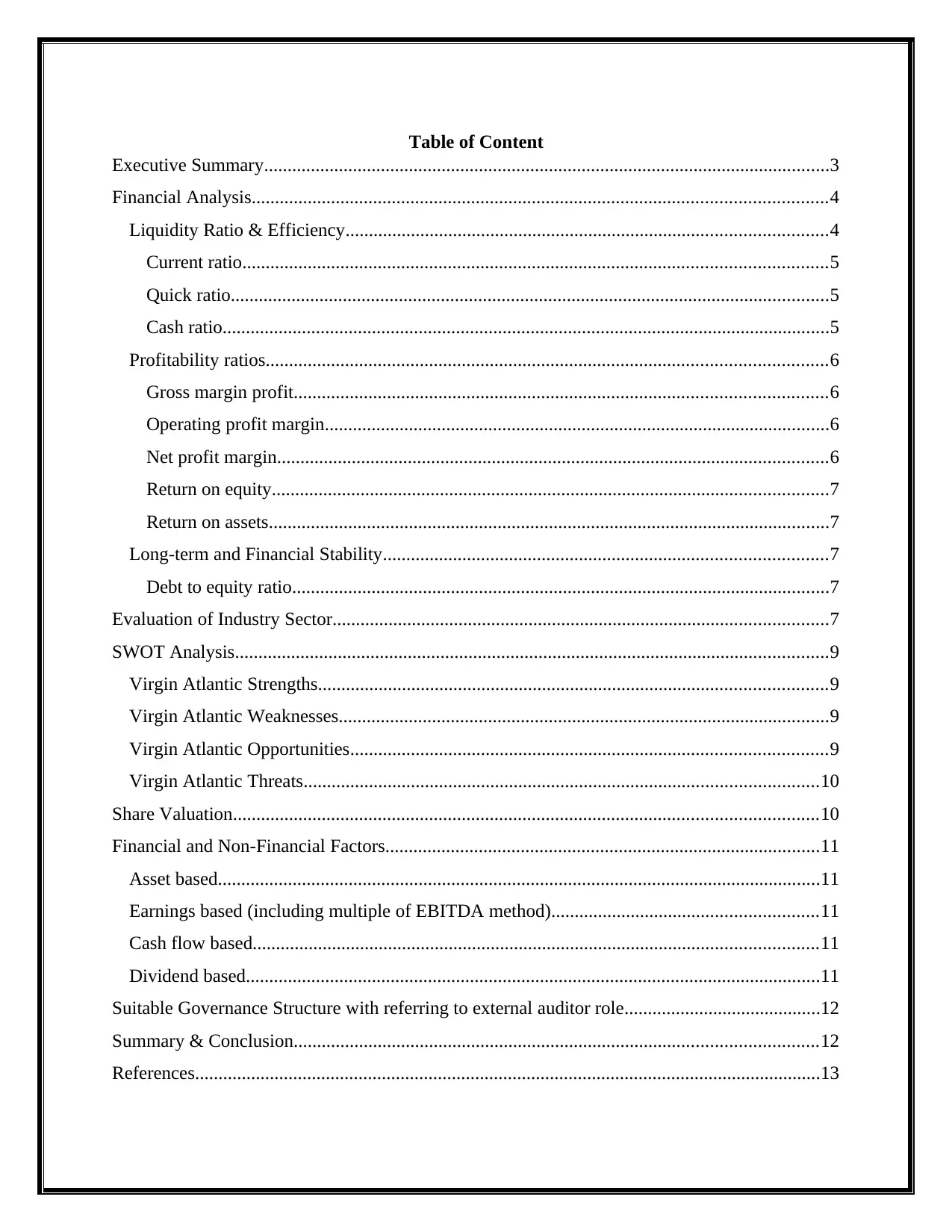
Table of Content
Executive Summary.........................................................................................................................3
Financial Analysis...........................................................................................................................4
Liquidity Ratio & Efficiency.......................................................................................................4
Current ratio.............................................................................................................................5
Quick ratio................................................................................................................................5
Cash ratio..................................................................................................................................5
Profitability ratios........................................................................................................................6
Gross margin profit..................................................................................................................6
Operating profit margin............................................................................................................6
Net profit margin......................................................................................................................6
Return on equity.......................................................................................................................7
Return on assets........................................................................................................................7
Long-term and Financial Stability...............................................................................................7
Debt to equity ratio...................................................................................................................7
Evaluation of Industry Sector..........................................................................................................7
SWOT Analysis...............................................................................................................................9
Virgin Atlantic Strengths.............................................................................................................9
Virgin Atlantic Weaknesses.........................................................................................................9
Virgin Atlantic Opportunities......................................................................................................9
Virgin Atlantic Threats..............................................................................................................10
Share Valuation.............................................................................................................................10
Financial and Non-Financial Factors.............................................................................................11
Asset based.................................................................................................................................11
Earnings based (including multiple of EBITDA method).........................................................11
Cash flow based.........................................................................................................................11
Dividend based...........................................................................................................................11
Suitable Governance Structure with referring to external auditor role..........................................12
Summary & Conclusion................................................................................................................12
References......................................................................................................................................13
Executive Summary.........................................................................................................................3
Financial Analysis...........................................................................................................................4
Liquidity Ratio & Efficiency.......................................................................................................4
Current ratio.............................................................................................................................5
Quick ratio................................................................................................................................5
Cash ratio..................................................................................................................................5
Profitability ratios........................................................................................................................6
Gross margin profit..................................................................................................................6
Operating profit margin............................................................................................................6
Net profit margin......................................................................................................................6
Return on equity.......................................................................................................................7
Return on assets........................................................................................................................7
Long-term and Financial Stability...............................................................................................7
Debt to equity ratio...................................................................................................................7
Evaluation of Industry Sector..........................................................................................................7
SWOT Analysis...............................................................................................................................9
Virgin Atlantic Strengths.............................................................................................................9
Virgin Atlantic Weaknesses.........................................................................................................9
Virgin Atlantic Opportunities......................................................................................................9
Virgin Atlantic Threats..............................................................................................................10
Share Valuation.............................................................................................................................10
Financial and Non-Financial Factors.............................................................................................11
Asset based.................................................................................................................................11
Earnings based (including multiple of EBITDA method).........................................................11
Cash flow based.........................................................................................................................11
Dividend based...........................................................................................................................11
Suitable Governance Structure with referring to external auditor role..........................................12
Summary & Conclusion................................................................................................................12
References......................................................................................................................................13

Executive Summary
The objective of this report is to examine the financial performance of Virgin Atlantic which is
operating as the private airline company in Australia for the period of 5 years ranges from 2018
to 2022. This report also examines the industry sector in which Virgin Atlantic is operating along
with the performance of three listed companies which are Ryan Air, British Airways and Jet 2
PLC. This report also examines the internal analysis of the company by implementing the SWOT
analysis of the company in which the relative strengths, weaknesses, opportunities and threats of
the company has been examined along with the pre and post share valuation for IPO.
In this report, the financial and non-financial factors are also examined that could have potential
impact on the valuation of the company along with Suitable Governance Structure with referring
to external auditor role. Lastly, this report ends with the conclusion which highlights the
important findings of this report
The objective of this report is to examine the financial performance of Virgin Atlantic which is
operating as the private airline company in Australia for the period of 5 years ranges from 2018
to 2022. This report also examines the industry sector in which Virgin Atlantic is operating along
with the performance of three listed companies which are Ryan Air, British Airways and Jet 2
PLC. This report also examines the internal analysis of the company by implementing the SWOT
analysis of the company in which the relative strengths, weaknesses, opportunities and threats of
the company has been examined along with the pre and post share valuation for IPO.
In this report, the financial and non-financial factors are also examined that could have potential
impact on the valuation of the company along with Suitable Governance Structure with referring
to external auditor role. Lastly, this report ends with the conclusion which highlights the
important findings of this report
⊘ This is a preview!⊘
Do you want full access?
Subscribe today to unlock all pages.

Trusted by 1+ million students worldwide
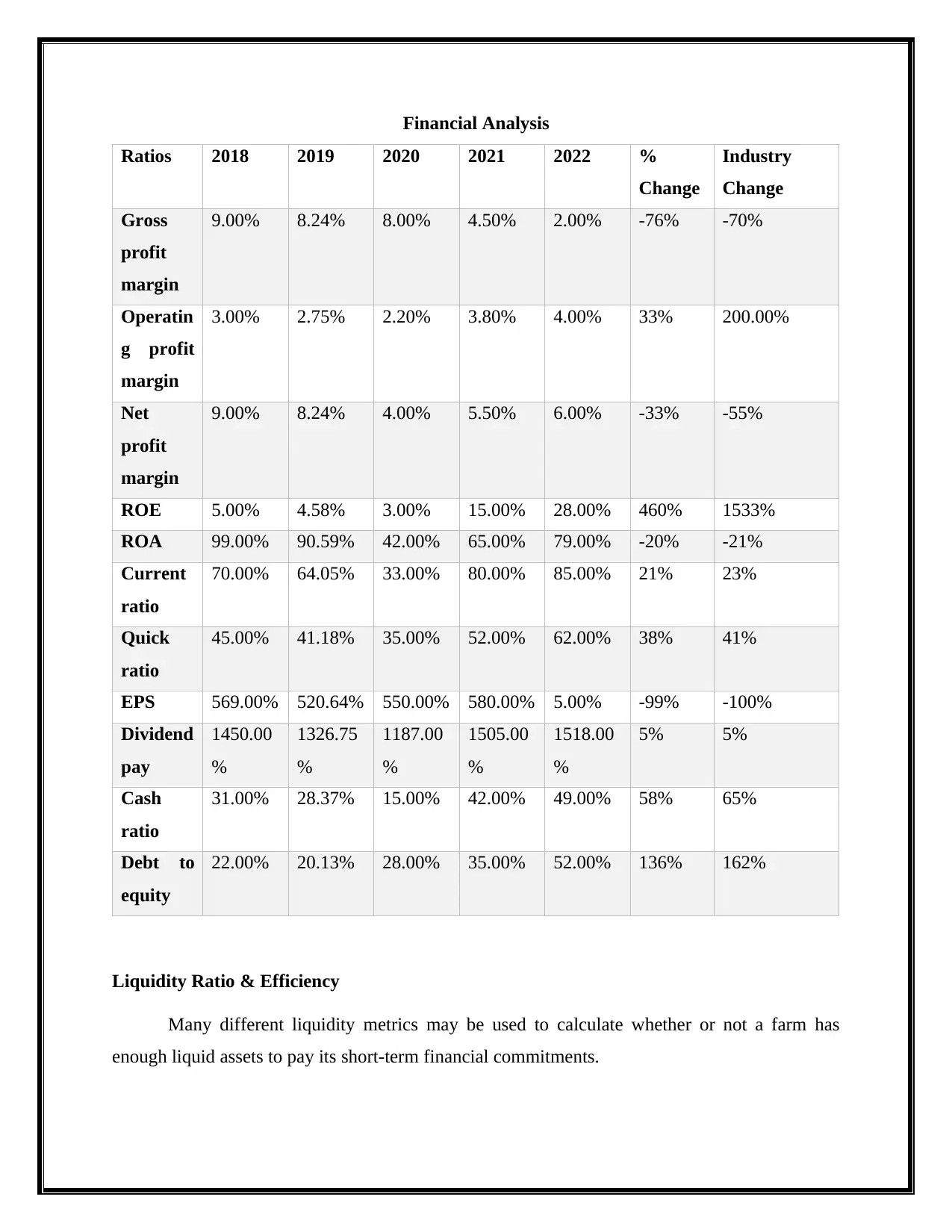
Financial Analysis
Ratios 2018 2019 2020 2021 2022 %
Change
Industry
Change
Gross
profit
margin
9.00% 8.24% 8.00% 4.50% 2.00% -76% -70%
Operatin
g profit
margin
3.00% 2.75% 2.20% 3.80% 4.00% 33% 200.00%
Net
profit
margin
9.00% 8.24% 4.00% 5.50% 6.00% -33% -55%
ROE 5.00% 4.58% 3.00% 15.00% 28.00% 460% 1533%
ROA 99.00% 90.59% 42.00% 65.00% 79.00% -20% -21%
Current
ratio
70.00% 64.05% 33.00% 80.00% 85.00% 21% 23%
Quick
ratio
45.00% 41.18% 35.00% 52.00% 62.00% 38% 41%
EPS 569.00% 520.64% 550.00% 580.00% 5.00% -99% -100%
Dividend
pay
1450.00
%
1326.75
%
1187.00
%
1505.00
%
1518.00
%
5% 5%
Cash
ratio
31.00% 28.37% 15.00% 42.00% 49.00% 58% 65%
Debt to
equity
22.00% 20.13% 28.00% 35.00% 52.00% 136% 162%
Liquidity Ratio & Efficiency
Many different liquidity metrics may be used to calculate whether or not a farm has
enough liquid assets to pay its short-term financial commitments.
Ratios 2018 2019 2020 2021 2022 %
Change
Industry
Change
Gross
profit
margin
9.00% 8.24% 8.00% 4.50% 2.00% -76% -70%
Operatin
g profit
margin
3.00% 2.75% 2.20% 3.80% 4.00% 33% 200.00%
Net
profit
margin
9.00% 8.24% 4.00% 5.50% 6.00% -33% -55%
ROE 5.00% 4.58% 3.00% 15.00% 28.00% 460% 1533%
ROA 99.00% 90.59% 42.00% 65.00% 79.00% -20% -21%
Current
ratio
70.00% 64.05% 33.00% 80.00% 85.00% 21% 23%
Quick
ratio
45.00% 41.18% 35.00% 52.00% 62.00% 38% 41%
EPS 569.00% 520.64% 550.00% 580.00% 5.00% -99% -100%
Dividend
pay
1450.00
%
1326.75
%
1187.00
%
1505.00
%
1518.00
%
5% 5%
Cash
ratio
31.00% 28.37% 15.00% 42.00% 49.00% 58% 65%
Debt to
equity
22.00% 20.13% 28.00% 35.00% 52.00% 136% 162%
Liquidity Ratio & Efficiency
Many different liquidity metrics may be used to calculate whether or not a farm has
enough liquid assets to pay its short-term financial commitments.
Paraphrase This Document
Need a fresh take? Get an instant paraphrase of this document with our AI Paraphraser
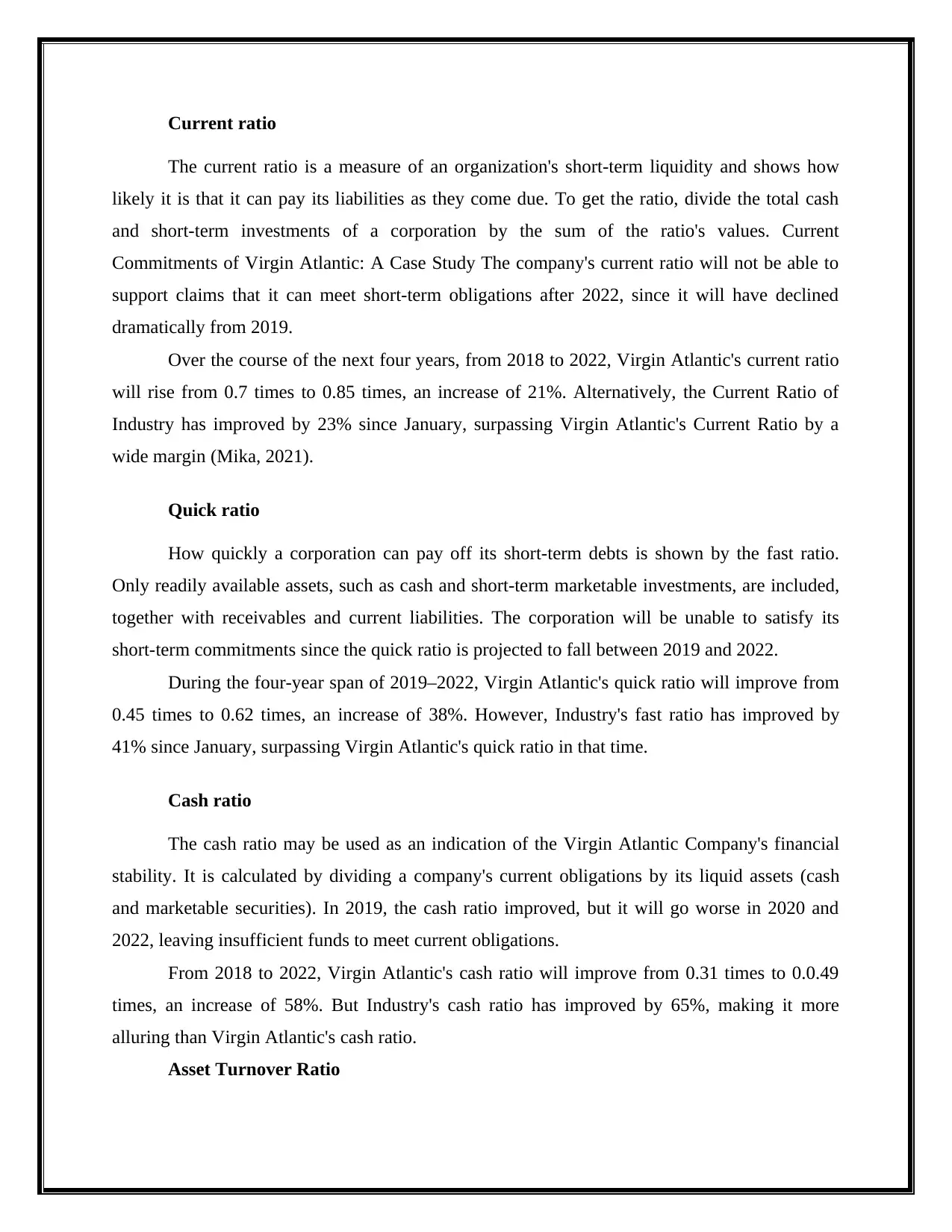
Current ratio
The current ratio is a measure of an organization's short-term liquidity and shows how
likely it is that it can pay its liabilities as they come due. To get the ratio, divide the total cash
and short-term investments of a corporation by the sum of the ratio's values. Current
Commitments of Virgin Atlantic: A Case Study The company's current ratio will not be able to
support claims that it can meet short-term obligations after 2022, since it will have declined
dramatically from 2019.
Over the course of the next four years, from 2018 to 2022, Virgin Atlantic's current ratio
will rise from 0.7 times to 0.85 times, an increase of 21%. Alternatively, the Current Ratio of
Industry has improved by 23% since January, surpassing Virgin Atlantic's Current Ratio by a
wide margin (Mika, 2021).
Quick ratio
How quickly a corporation can pay off its short-term debts is shown by the fast ratio.
Only readily available assets, such as cash and short-term marketable investments, are included,
together with receivables and current liabilities. The corporation will be unable to satisfy its
short-term commitments since the quick ratio is projected to fall between 2019 and 2022.
During the four-year span of 2019–2022, Virgin Atlantic's quick ratio will improve from
0.45 times to 0.62 times, an increase of 38%. However, Industry's fast ratio has improved by
41% since January, surpassing Virgin Atlantic's quick ratio in that time.
Cash ratio
The cash ratio may be used as an indication of the Virgin Atlantic Company's financial
stability. It is calculated by dividing a company's current obligations by its liquid assets (cash
and marketable securities). In 2019, the cash ratio improved, but it will go worse in 2020 and
2022, leaving insufficient funds to meet current obligations.
From 2018 to 2022, Virgin Atlantic's cash ratio will improve from 0.31 times to 0.0.49
times, an increase of 58%. But Industry's cash ratio has improved by 65%, making it more
alluring than Virgin Atlantic's cash ratio.
Asset Turnover Ratio
The current ratio is a measure of an organization's short-term liquidity and shows how
likely it is that it can pay its liabilities as they come due. To get the ratio, divide the total cash
and short-term investments of a corporation by the sum of the ratio's values. Current
Commitments of Virgin Atlantic: A Case Study The company's current ratio will not be able to
support claims that it can meet short-term obligations after 2022, since it will have declined
dramatically from 2019.
Over the course of the next four years, from 2018 to 2022, Virgin Atlantic's current ratio
will rise from 0.7 times to 0.85 times, an increase of 21%. Alternatively, the Current Ratio of
Industry has improved by 23% since January, surpassing Virgin Atlantic's Current Ratio by a
wide margin (Mika, 2021).
Quick ratio
How quickly a corporation can pay off its short-term debts is shown by the fast ratio.
Only readily available assets, such as cash and short-term marketable investments, are included,
together with receivables and current liabilities. The corporation will be unable to satisfy its
short-term commitments since the quick ratio is projected to fall between 2019 and 2022.
During the four-year span of 2019–2022, Virgin Atlantic's quick ratio will improve from
0.45 times to 0.62 times, an increase of 38%. However, Industry's fast ratio has improved by
41% since January, surpassing Virgin Atlantic's quick ratio in that time.
Cash ratio
The cash ratio may be used as an indication of the Virgin Atlantic Company's financial
stability. It is calculated by dividing a company's current obligations by its liquid assets (cash
and marketable securities). In 2019, the cash ratio improved, but it will go worse in 2020 and
2022, leaving insufficient funds to meet current obligations.
From 2018 to 2022, Virgin Atlantic's cash ratio will improve from 0.31 times to 0.0.49
times, an increase of 58%. But Industry's cash ratio has improved by 65%, making it more
alluring than Virgin Atlantic's cash ratio.
Asset Turnover Ratio
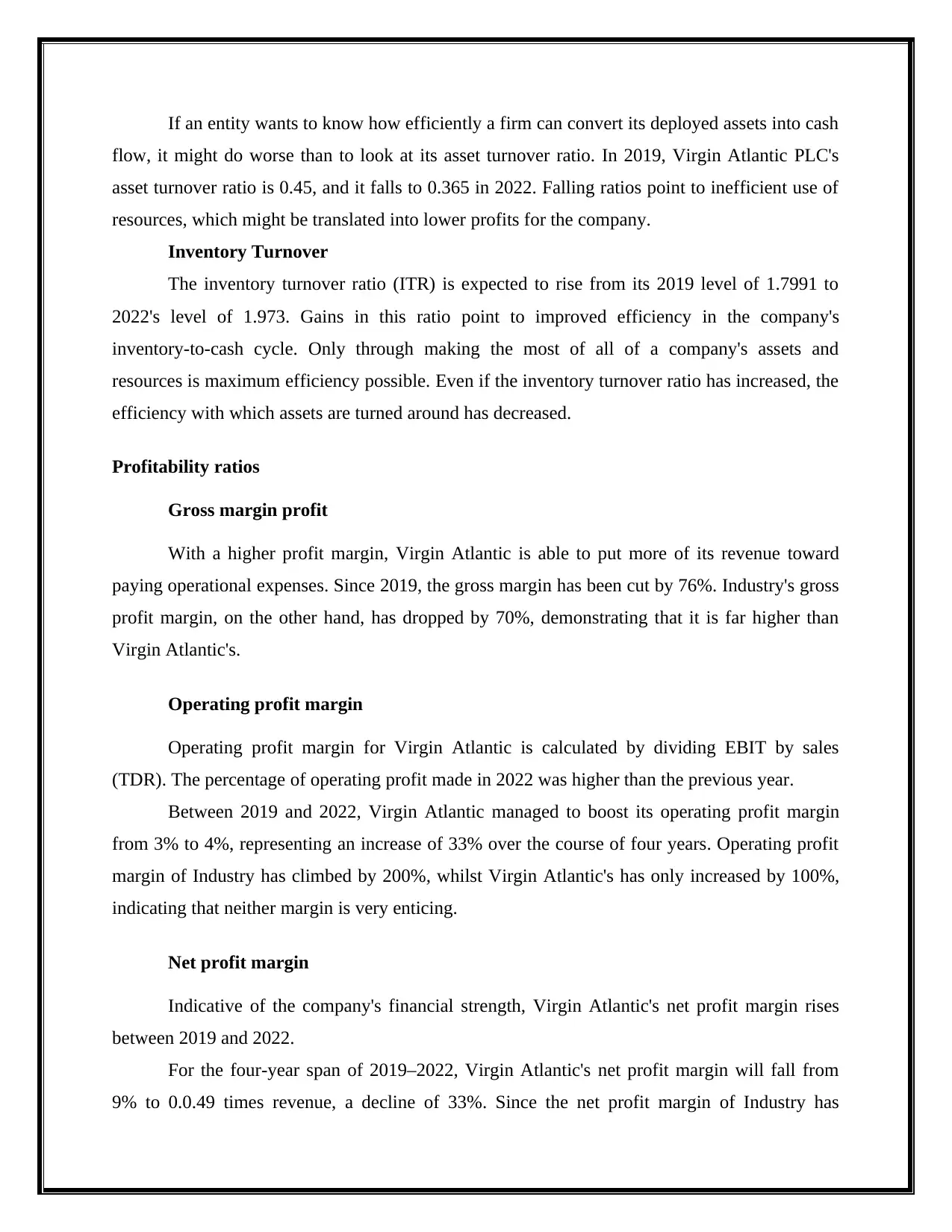
If an entity wants to know how efficiently a firm can convert its deployed assets into cash
flow, it might do worse than to look at its asset turnover ratio. In 2019, Virgin Atlantic PLC's
asset turnover ratio is 0.45, and it falls to 0.365 in 2022. Falling ratios point to inefficient use of
resources, which might be translated into lower profits for the company.
Inventory Turnover
The inventory turnover ratio (ITR) is expected to rise from its 2019 level of 1.7991 to
2022's level of 1.973. Gains in this ratio point to improved efficiency in the company's
inventory-to-cash cycle. Only through making the most of all of a company's assets and
resources is maximum efficiency possible. Even if the inventory turnover ratio has increased, the
efficiency with which assets are turned around has decreased.
Profitability ratios
Gross margin profit
With a higher profit margin, Virgin Atlantic is able to put more of its revenue toward
paying operational expenses. Since 2019, the gross margin has been cut by 76%. Industry's gross
profit margin, on the other hand, has dropped by 70%, demonstrating that it is far higher than
Virgin Atlantic's.
Operating profit margin
Operating profit margin for Virgin Atlantic is calculated by dividing EBIT by sales
(TDR). The percentage of operating profit made in 2022 was higher than the previous year.
Between 2019 and 2022, Virgin Atlantic managed to boost its operating profit margin
from 3% to 4%, representing an increase of 33% over the course of four years. Operating profit
margin of Industry has climbed by 200%, whilst Virgin Atlantic's has only increased by 100%,
indicating that neither margin is very enticing.
Net profit margin
Indicative of the company's financial strength, Virgin Atlantic's net profit margin rises
between 2019 and 2022.
For the four-year span of 2019–2022, Virgin Atlantic's net profit margin will fall from
9% to 0.0.49 times revenue, a decline of 33%. Since the net profit margin of Industry has
flow, it might do worse than to look at its asset turnover ratio. In 2019, Virgin Atlantic PLC's
asset turnover ratio is 0.45, and it falls to 0.365 in 2022. Falling ratios point to inefficient use of
resources, which might be translated into lower profits for the company.
Inventory Turnover
The inventory turnover ratio (ITR) is expected to rise from its 2019 level of 1.7991 to
2022's level of 1.973. Gains in this ratio point to improved efficiency in the company's
inventory-to-cash cycle. Only through making the most of all of a company's assets and
resources is maximum efficiency possible. Even if the inventory turnover ratio has increased, the
efficiency with which assets are turned around has decreased.
Profitability ratios
Gross margin profit
With a higher profit margin, Virgin Atlantic is able to put more of its revenue toward
paying operational expenses. Since 2019, the gross margin has been cut by 76%. Industry's gross
profit margin, on the other hand, has dropped by 70%, demonstrating that it is far higher than
Virgin Atlantic's.
Operating profit margin
Operating profit margin for Virgin Atlantic is calculated by dividing EBIT by sales
(TDR). The percentage of operating profit made in 2022 was higher than the previous year.
Between 2019 and 2022, Virgin Atlantic managed to boost its operating profit margin
from 3% to 4%, representing an increase of 33% over the course of four years. Operating profit
margin of Industry has climbed by 200%, whilst Virgin Atlantic's has only increased by 100%,
indicating that neither margin is very enticing.
Net profit margin
Indicative of the company's financial strength, Virgin Atlantic's net profit margin rises
between 2019 and 2022.
For the four-year span of 2019–2022, Virgin Atlantic's net profit margin will fall from
9% to 0.0.49 times revenue, a decline of 33%. Since the net profit margin of Industry has
⊘ This is a preview!⊘
Do you want full access?
Subscribe today to unlock all pages.

Trusted by 1+ million students worldwide
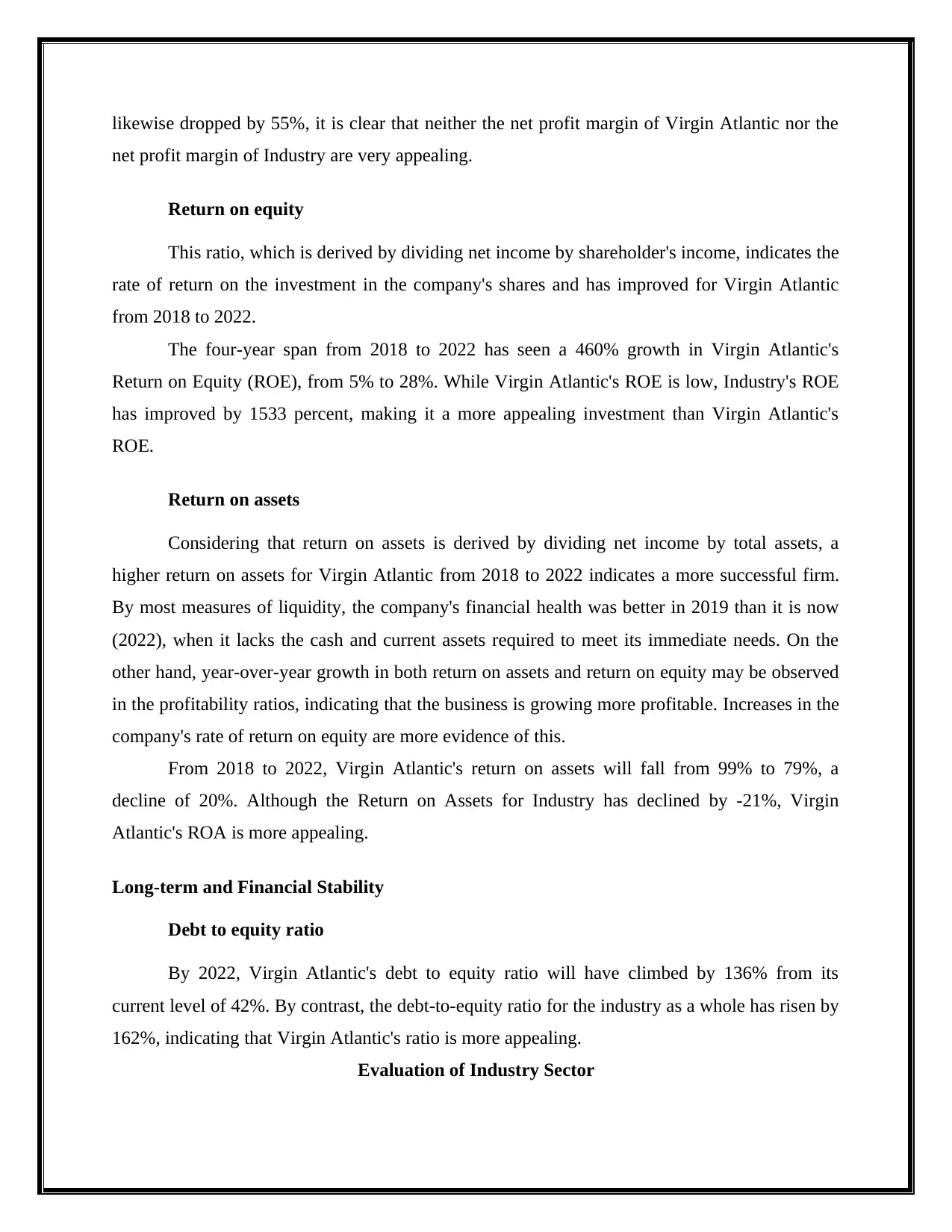
likewise dropped by 55%, it is clear that neither the net profit margin of Virgin Atlantic nor the
net profit margin of Industry are very appealing.
Return on equity
This ratio, which is derived by dividing net income by shareholder's income, indicates the
rate of return on the investment in the company's shares and has improved for Virgin Atlantic
from 2018 to 2022.
The four-year span from 2018 to 2022 has seen a 460% growth in Virgin Atlantic's
Return on Equity (ROE), from 5% to 28%. While Virgin Atlantic's ROE is low, Industry's ROE
has improved by 1533 percent, making it a more appealing investment than Virgin Atlantic's
ROE.
Return on assets
Considering that return on assets is derived by dividing net income by total assets, a
higher return on assets for Virgin Atlantic from 2018 to 2022 indicates a more successful firm.
By most measures of liquidity, the company's financial health was better in 2019 than it is now
(2022), when it lacks the cash and current assets required to meet its immediate needs. On the
other hand, year-over-year growth in both return on assets and return on equity may be observed
in the profitability ratios, indicating that the business is growing more profitable. Increases in the
company's rate of return on equity are more evidence of this.
From 2018 to 2022, Virgin Atlantic's return on assets will fall from 99% to 79%, a
decline of 20%. Although the Return on Assets for Industry has declined by -21%, Virgin
Atlantic's ROA is more appealing.
Long-term and Financial Stability
Debt to equity ratio
By 2022, Virgin Atlantic's debt to equity ratio will have climbed by 136% from its
current level of 42%. By contrast, the debt-to-equity ratio for the industry as a whole has risen by
162%, indicating that Virgin Atlantic's ratio is more appealing.
Evaluation of Industry Sector
net profit margin of Industry are very appealing.
Return on equity
This ratio, which is derived by dividing net income by shareholder's income, indicates the
rate of return on the investment in the company's shares and has improved for Virgin Atlantic
from 2018 to 2022.
The four-year span from 2018 to 2022 has seen a 460% growth in Virgin Atlantic's
Return on Equity (ROE), from 5% to 28%. While Virgin Atlantic's ROE is low, Industry's ROE
has improved by 1533 percent, making it a more appealing investment than Virgin Atlantic's
ROE.
Return on assets
Considering that return on assets is derived by dividing net income by total assets, a
higher return on assets for Virgin Atlantic from 2018 to 2022 indicates a more successful firm.
By most measures of liquidity, the company's financial health was better in 2019 than it is now
(2022), when it lacks the cash and current assets required to meet its immediate needs. On the
other hand, year-over-year growth in both return on assets and return on equity may be observed
in the profitability ratios, indicating that the business is growing more profitable. Increases in the
company's rate of return on equity are more evidence of this.
From 2018 to 2022, Virgin Atlantic's return on assets will fall from 99% to 79%, a
decline of 20%. Although the Return on Assets for Industry has declined by -21%, Virgin
Atlantic's ROA is more appealing.
Long-term and Financial Stability
Debt to equity ratio
By 2022, Virgin Atlantic's debt to equity ratio will have climbed by 136% from its
current level of 42%. By contrast, the debt-to-equity ratio for the industry as a whole has risen by
162%, indicating that Virgin Atlantic's ratio is more appealing.
Evaluation of Industry Sector
Paraphrase This Document
Need a fresh take? Get an instant paraphrase of this document with our AI Paraphraser
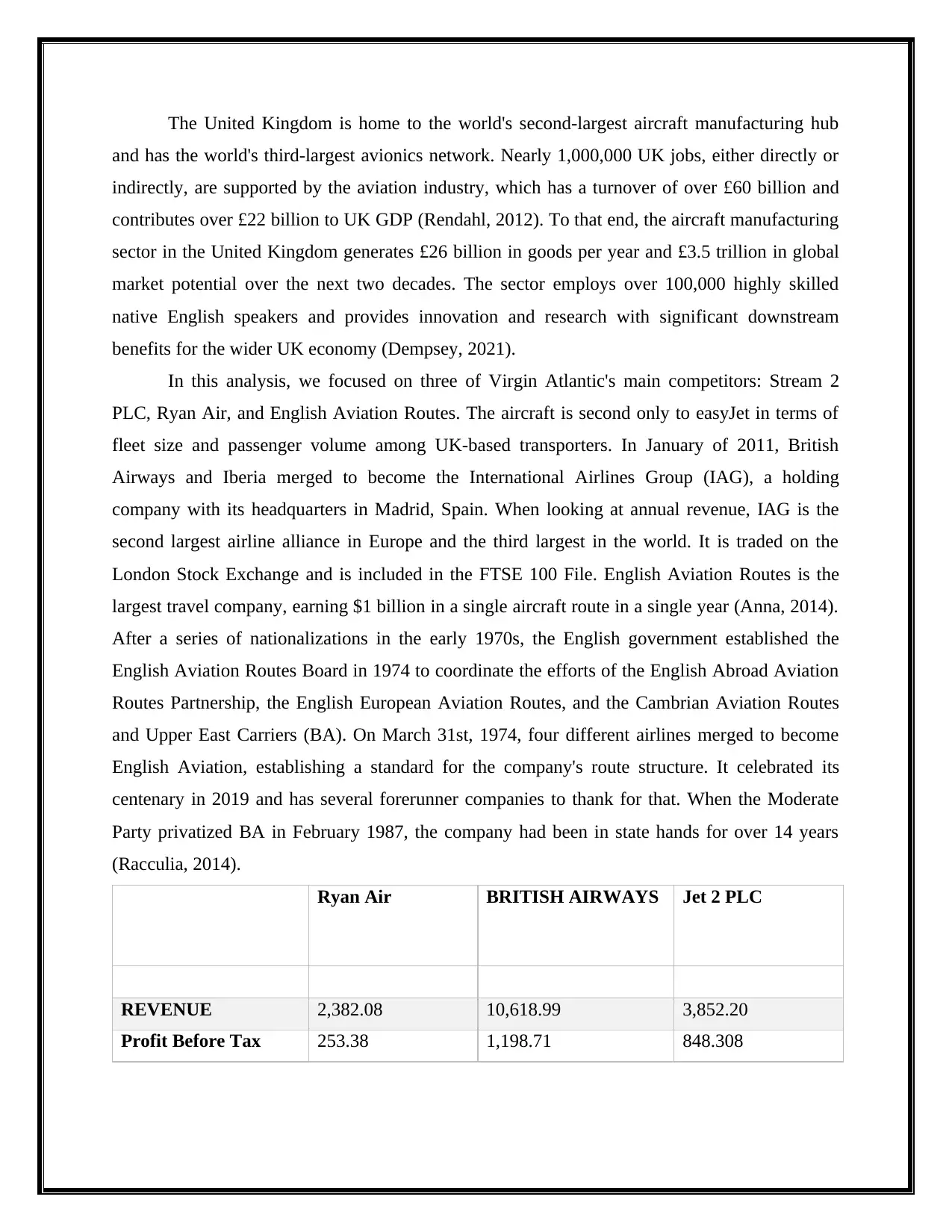
The United Kingdom is home to the world's second-largest aircraft manufacturing hub
and has the world's third-largest avionics network. Nearly 1,000,000 UK jobs, either directly or
indirectly, are supported by the aviation industry, which has a turnover of over £60 billion and
contributes over £22 billion to UK GDP (Rendahl, 2012). To that end, the aircraft manufacturing
sector in the United Kingdom generates £26 billion in goods per year and £3.5 trillion in global
market potential over the next two decades. The sector employs over 100,000 highly skilled
native English speakers and provides innovation and research with significant downstream
benefits for the wider UK economy (Dempsey, 2021).
In this analysis, we focused on three of Virgin Atlantic's main competitors: Stream 2
PLC, Ryan Air, and English Aviation Routes. The aircraft is second only to easyJet in terms of
fleet size and passenger volume among UK-based transporters. In January of 2011, British
Airways and Iberia merged to become the International Airlines Group (IAG), a holding
company with its headquarters in Madrid, Spain. When looking at annual revenue, IAG is the
second largest airline alliance in Europe and the third largest in the world. It is traded on the
London Stock Exchange and is included in the FTSE 100 File. English Aviation Routes is the
largest travel company, earning $1 billion in a single aircraft route in a single year (Anna, 2014).
After a series of nationalizations in the early 1970s, the English government established the
English Aviation Routes Board in 1974 to coordinate the efforts of the English Abroad Aviation
Routes Partnership, the English European Aviation Routes, and the Cambrian Aviation Routes
and Upper East Carriers (BA). On March 31st, 1974, four different airlines merged to become
English Aviation, establishing a standard for the company's route structure. It celebrated its
centenary in 2019 and has several forerunner companies to thank for that. When the Moderate
Party privatized BA in February 1987, the company had been in state hands for over 14 years
(Racculia, 2014).
Ryan Air BRITISH AIRWAYS Jet 2 PLC
REVENUE 2,382.08 10,618.99 3,852.20
Profit Before Tax 253.38 1,198.71 848.308
and has the world's third-largest avionics network. Nearly 1,000,000 UK jobs, either directly or
indirectly, are supported by the aviation industry, which has a turnover of over £60 billion and
contributes over £22 billion to UK GDP (Rendahl, 2012). To that end, the aircraft manufacturing
sector in the United Kingdom generates £26 billion in goods per year and £3.5 trillion in global
market potential over the next two decades. The sector employs over 100,000 highly skilled
native English speakers and provides innovation and research with significant downstream
benefits for the wider UK economy (Dempsey, 2021).
In this analysis, we focused on three of Virgin Atlantic's main competitors: Stream 2
PLC, Ryan Air, and English Aviation Routes. The aircraft is second only to easyJet in terms of
fleet size and passenger volume among UK-based transporters. In January of 2011, British
Airways and Iberia merged to become the International Airlines Group (IAG), a holding
company with its headquarters in Madrid, Spain. When looking at annual revenue, IAG is the
second largest airline alliance in Europe and the third largest in the world. It is traded on the
London Stock Exchange and is included in the FTSE 100 File. English Aviation Routes is the
largest travel company, earning $1 billion in a single aircraft route in a single year (Anna, 2014).
After a series of nationalizations in the early 1970s, the English government established the
English Aviation Routes Board in 1974 to coordinate the efforts of the English Abroad Aviation
Routes Partnership, the English European Aviation Routes, and the Cambrian Aviation Routes
and Upper East Carriers (BA). On March 31st, 1974, four different airlines merged to become
English Aviation, establishing a standard for the company's route structure. It celebrated its
centenary in 2019 and has several forerunner companies to thank for that. When the Moderate
Party privatized BA in February 1987, the company had been in state hands for over 14 years
(Racculia, 2014).
Ryan Air BRITISH AIRWAYS Jet 2 PLC
REVENUE 2,382.08 10,618.99 3,852.20
Profit Before Tax 253.38 1,198.71 848.308
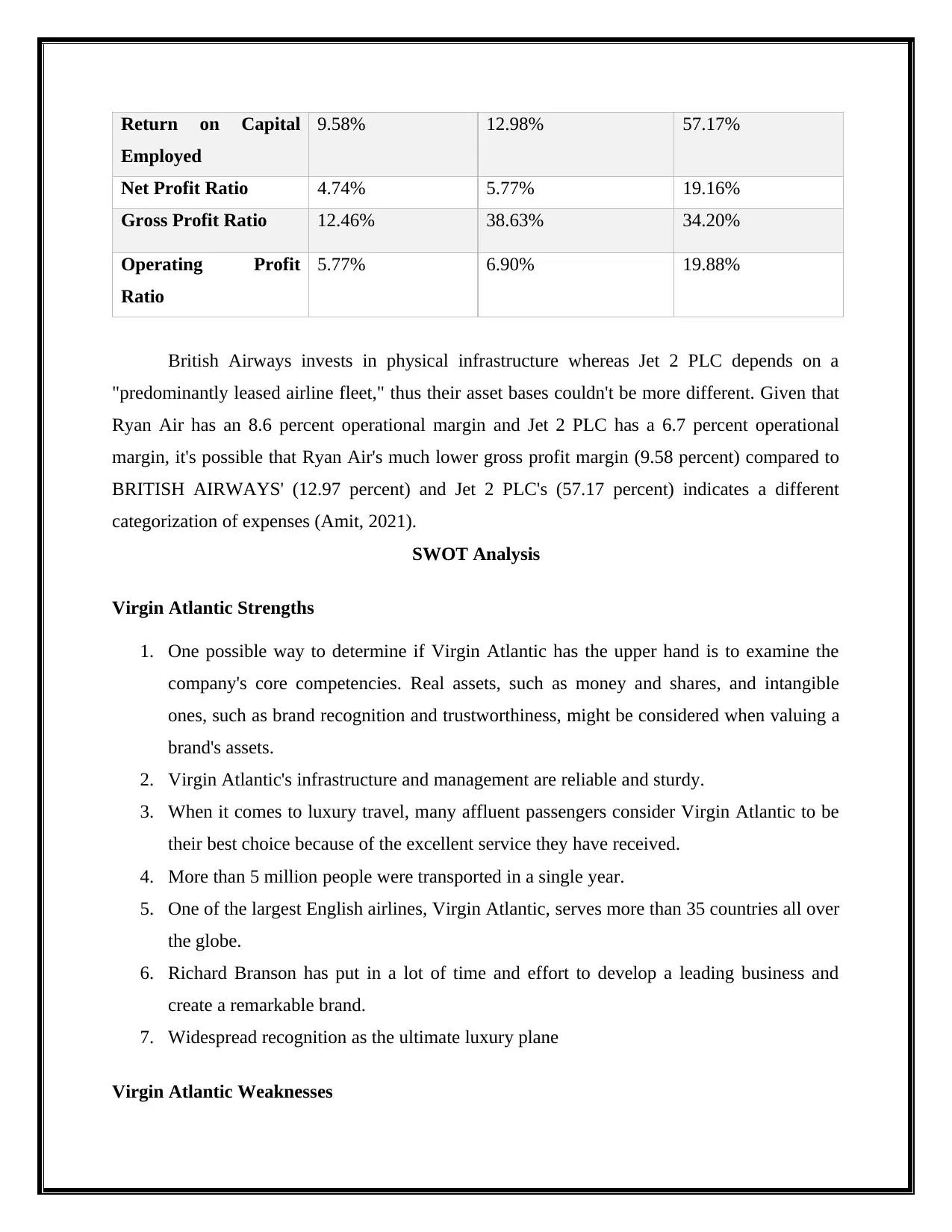
Return on Capital
Employed
9.58% 12.98% 57.17%
Net Profit Ratio 4.74% 5.77% 19.16%
Gross Profit Ratio 12.46% 38.63% 34.20%
Operating Profit
Ratio
5.77% 6.90% 19.88%
British Airways invests in physical infrastructure whereas Jet 2 PLC depends on a
"predominantly leased airline fleet," thus their asset bases couldn't be more different. Given that
Ryan Air has an 8.6 percent operational margin and Jet 2 PLC has a 6.7 percent operational
margin, it's possible that Ryan Air's much lower gross profit margin (9.58 percent) compared to
BRITISH AIRWAYS' (12.97 percent) and Jet 2 PLC's (57.17 percent) indicates a different
categorization of expenses (Amit, 2021).
SWOT Analysis
Virgin Atlantic Strengths
1. One possible way to determine if Virgin Atlantic has the upper hand is to examine the
company's core competencies. Real assets, such as money and shares, and intangible
ones, such as brand recognition and trustworthiness, might be considered when valuing a
brand's assets.
2. Virgin Atlantic's infrastructure and management are reliable and sturdy.
3. When it comes to luxury travel, many affluent passengers consider Virgin Atlantic to be
their best choice because of the excellent service they have received.
4. More than 5 million people were transported in a single year.
5. One of the largest English airlines, Virgin Atlantic, serves more than 35 countries all over
the globe.
6. Richard Branson has put in a lot of time and effort to develop a leading business and
create a remarkable brand.
7. Widespread recognition as the ultimate luxury plane
Virgin Atlantic Weaknesses
Employed
9.58% 12.98% 57.17%
Net Profit Ratio 4.74% 5.77% 19.16%
Gross Profit Ratio 12.46% 38.63% 34.20%
Operating Profit
Ratio
5.77% 6.90% 19.88%
British Airways invests in physical infrastructure whereas Jet 2 PLC depends on a
"predominantly leased airline fleet," thus their asset bases couldn't be more different. Given that
Ryan Air has an 8.6 percent operational margin and Jet 2 PLC has a 6.7 percent operational
margin, it's possible that Ryan Air's much lower gross profit margin (9.58 percent) compared to
BRITISH AIRWAYS' (12.97 percent) and Jet 2 PLC's (57.17 percent) indicates a different
categorization of expenses (Amit, 2021).
SWOT Analysis
Virgin Atlantic Strengths
1. One possible way to determine if Virgin Atlantic has the upper hand is to examine the
company's core competencies. Real assets, such as money and shares, and intangible
ones, such as brand recognition and trustworthiness, might be considered when valuing a
brand's assets.
2. Virgin Atlantic's infrastructure and management are reliable and sturdy.
3. When it comes to luxury travel, many affluent passengers consider Virgin Atlantic to be
their best choice because of the excellent service they have received.
4. More than 5 million people were transported in a single year.
5. One of the largest English airlines, Virgin Atlantic, serves more than 35 countries all over
the globe.
6. Richard Branson has put in a lot of time and effort to develop a leading business and
create a remarkable brand.
7. Widespread recognition as the ultimate luxury plane
Virgin Atlantic Weaknesses
⊘ This is a preview!⊘
Do you want full access?
Subscribe today to unlock all pages.

Trusted by 1+ million students worldwide
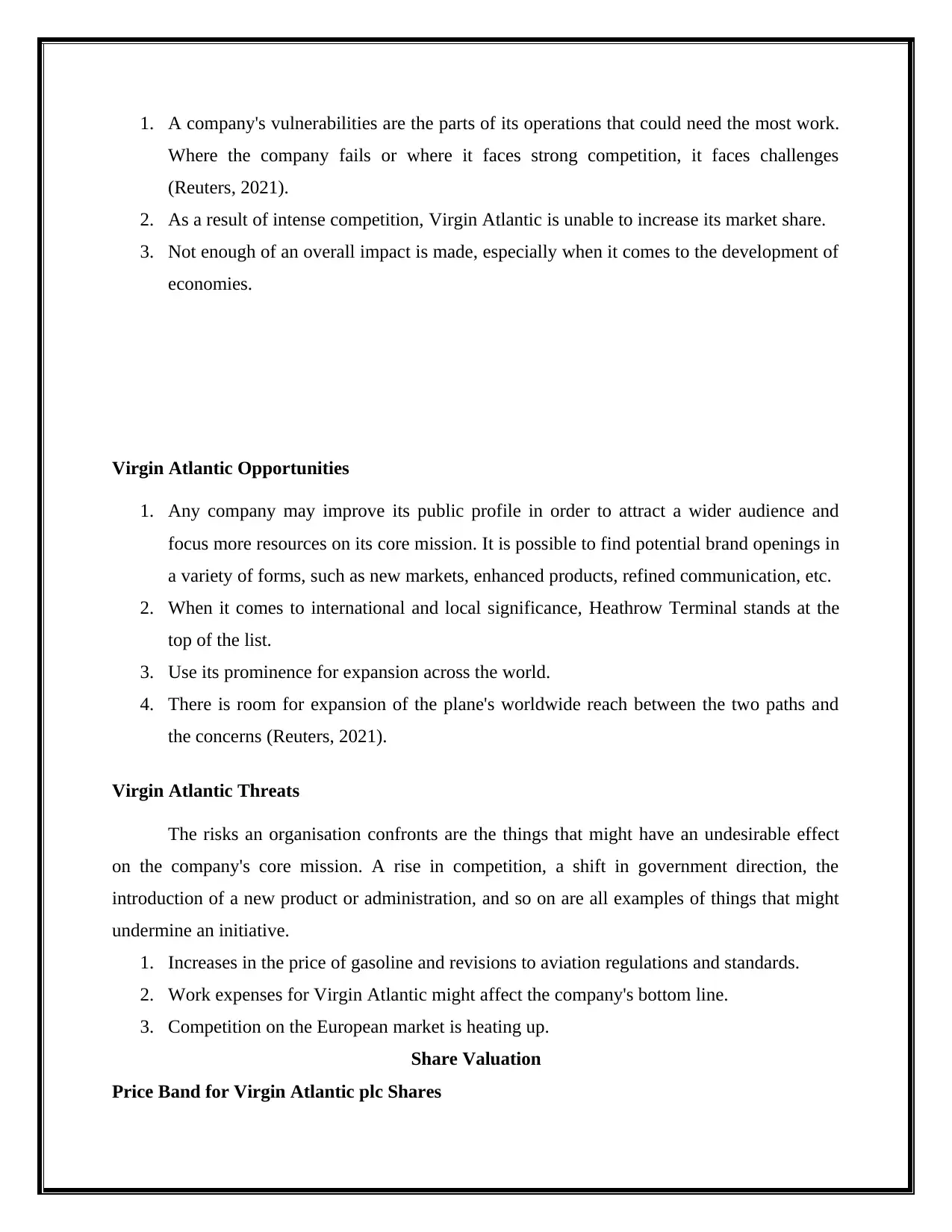
1. A company's vulnerabilities are the parts of its operations that could need the most work.
Where the company fails or where it faces strong competition, it faces challenges
(Reuters, 2021).
2. As a result of intense competition, Virgin Atlantic is unable to increase its market share.
3. Not enough of an overall impact is made, especially when it comes to the development of
economies.
Virgin Atlantic Opportunities
1. Any company may improve its public profile in order to attract a wider audience and
focus more resources on its core mission. It is possible to find potential brand openings in
a variety of forms, such as new markets, enhanced products, refined communication, etc.
2. When it comes to international and local significance, Heathrow Terminal stands at the
top of the list.
3. Use its prominence for expansion across the world.
4. There is room for expansion of the plane's worldwide reach between the two paths and
the concerns (Reuters, 2021).
Virgin Atlantic Threats
The risks an organisation confronts are the things that might have an undesirable effect
on the company's core mission. A rise in competition, a shift in government direction, the
introduction of a new product or administration, and so on are all examples of things that might
undermine an initiative.
1. Increases in the price of gasoline and revisions to aviation regulations and standards.
2. Work expenses for Virgin Atlantic might affect the company's bottom line.
3. Competition on the European market is heating up.
Share Valuation
Price Band for Virgin Atlantic plc Shares
Where the company fails or where it faces strong competition, it faces challenges
(Reuters, 2021).
2. As a result of intense competition, Virgin Atlantic is unable to increase its market share.
3. Not enough of an overall impact is made, especially when it comes to the development of
economies.
Virgin Atlantic Opportunities
1. Any company may improve its public profile in order to attract a wider audience and
focus more resources on its core mission. It is possible to find potential brand openings in
a variety of forms, such as new markets, enhanced products, refined communication, etc.
2. When it comes to international and local significance, Heathrow Terminal stands at the
top of the list.
3. Use its prominence for expansion across the world.
4. There is room for expansion of the plane's worldwide reach between the two paths and
the concerns (Reuters, 2021).
Virgin Atlantic Threats
The risks an organisation confronts are the things that might have an undesirable effect
on the company's core mission. A rise in competition, a shift in government direction, the
introduction of a new product or administration, and so on are all examples of things that might
undermine an initiative.
1. Increases in the price of gasoline and revisions to aviation regulations and standards.
2. Work expenses for Virgin Atlantic might affect the company's bottom line.
3. Competition on the European market is heating up.
Share Valuation
Price Band for Virgin Atlantic plc Shares
Paraphrase This Document
Need a fresh take? Get an instant paraphrase of this document with our AI Paraphraser
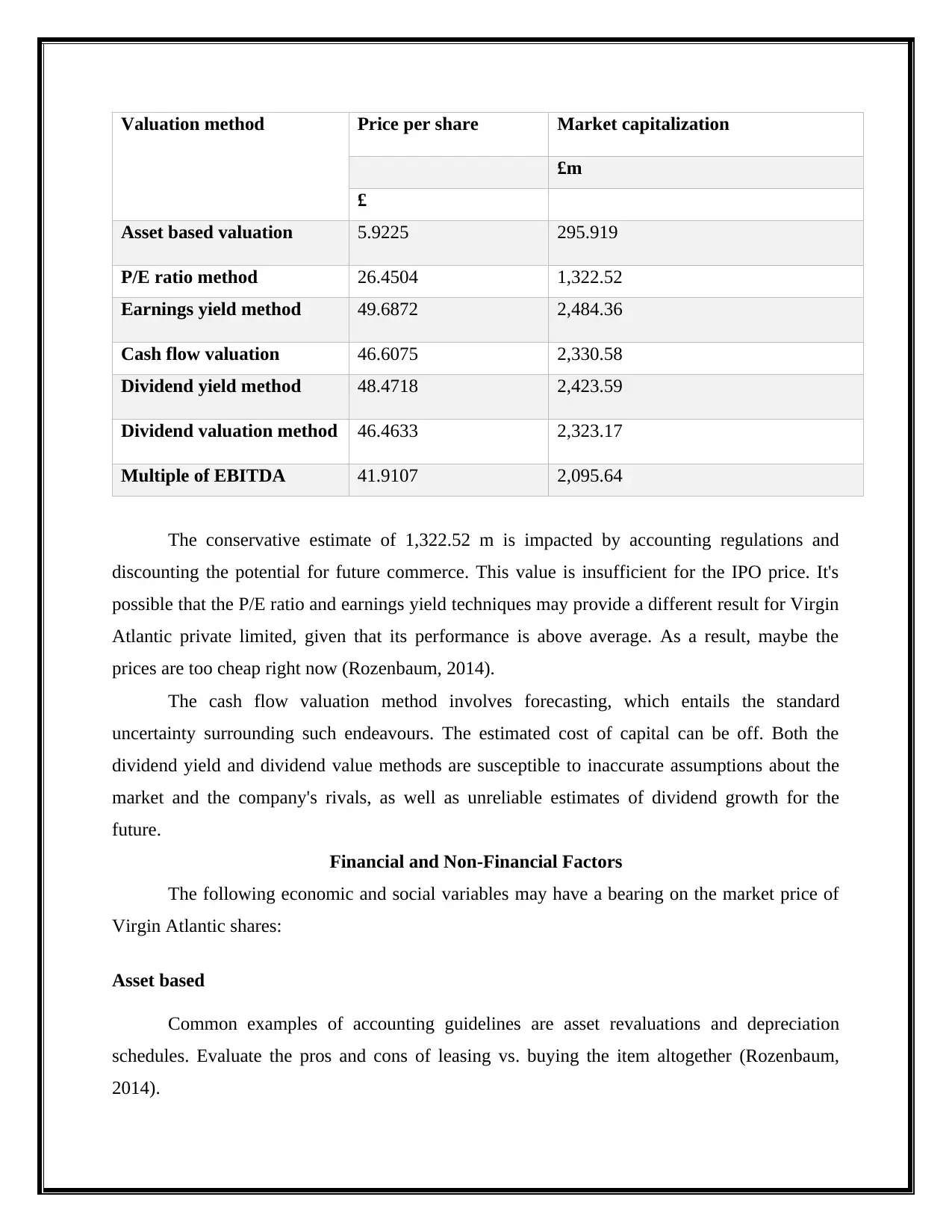
Valuation method Price per share Market capitalization
£m
£
Asset based valuation 5.9225 295.919
P/E ratio method 26.4504 1,322.52
Earnings yield method 49.6872 2,484.36
Cash flow valuation 46.6075 2,330.58
Dividend yield method 48.4718 2,423.59
Dividend valuation method 46.4633 2,323.17
Multiple of EBITDA 41.9107 2,095.64
The conservative estimate of 1,322.52 m is impacted by accounting regulations and
discounting the potential for future commerce. This value is insufficient for the IPO price. It's
possible that the P/E ratio and earnings yield techniques may provide a different result for Virgin
Atlantic private limited, given that its performance is above average. As a result, maybe the
prices are too cheap right now (Rozenbaum, 2014).
The cash flow valuation method involves forecasting, which entails the standard
uncertainty surrounding such endeavours. The estimated cost of capital can be off. Both the
dividend yield and dividend value methods are susceptible to inaccurate assumptions about the
market and the company's rivals, as well as unreliable estimates of dividend growth for the
future.
Financial and Non-Financial Factors
The following economic and social variables may have a bearing on the market price of
Virgin Atlantic shares:
Asset based
Common examples of accounting guidelines are asset revaluations and depreciation
schedules. Evaluate the pros and cons of leasing vs. buying the item altogether (Rozenbaum,
2014).
£m
£
Asset based valuation 5.9225 295.919
P/E ratio method 26.4504 1,322.52
Earnings yield method 49.6872 2,484.36
Cash flow valuation 46.6075 2,330.58
Dividend yield method 48.4718 2,423.59
Dividend valuation method 46.4633 2,323.17
Multiple of EBITDA 41.9107 2,095.64
The conservative estimate of 1,322.52 m is impacted by accounting regulations and
discounting the potential for future commerce. This value is insufficient for the IPO price. It's
possible that the P/E ratio and earnings yield techniques may provide a different result for Virgin
Atlantic private limited, given that its performance is above average. As a result, maybe the
prices are too cheap right now (Rozenbaum, 2014).
The cash flow valuation method involves forecasting, which entails the standard
uncertainty surrounding such endeavours. The estimated cost of capital can be off. Both the
dividend yield and dividend value methods are susceptible to inaccurate assumptions about the
market and the company's rivals, as well as unreliable estimates of dividend growth for the
future.
Financial and Non-Financial Factors
The following economic and social variables may have a bearing on the market price of
Virgin Atlantic shares:
Asset based
Common examples of accounting guidelines are asset revaluations and depreciation
schedules. Evaluate the pros and cons of leasing vs. buying the item altogether (Rozenbaum,
2014).
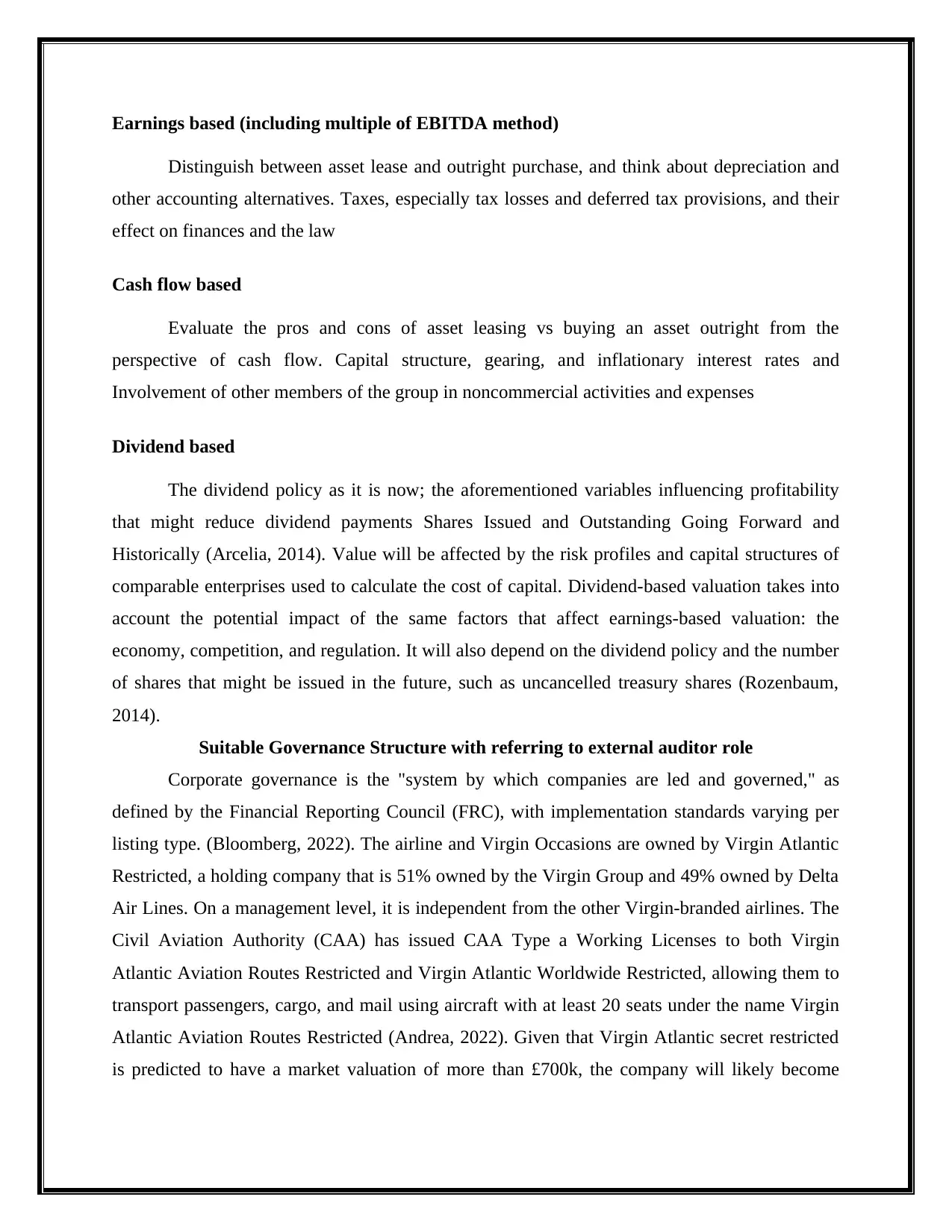
Earnings based (including multiple of EBITDA method)
Distinguish between asset lease and outright purchase, and think about depreciation and
other accounting alternatives. Taxes, especially tax losses and deferred tax provisions, and their
effect on finances and the law
Cash flow based
Evaluate the pros and cons of asset leasing vs buying an asset outright from the
perspective of cash flow. Capital structure, gearing, and inflationary interest rates and
Involvement of other members of the group in noncommercial activities and expenses
Dividend based
The dividend policy as it is now; the aforementioned variables influencing profitability
that might reduce dividend payments Shares Issued and Outstanding Going Forward and
Historically (Arcelia, 2014). Value will be affected by the risk profiles and capital structures of
comparable enterprises used to calculate the cost of capital. Dividend-based valuation takes into
account the potential impact of the same factors that affect earnings-based valuation: the
economy, competition, and regulation. It will also depend on the dividend policy and the number
of shares that might be issued in the future, such as uncancelled treasury shares (Rozenbaum,
2014).
Suitable Governance Structure with referring to external auditor role
Corporate governance is the "system by which companies are led and governed," as
defined by the Financial Reporting Council (FRC), with implementation standards varying per
listing type. (Bloomberg, 2022). The airline and Virgin Occasions are owned by Virgin Atlantic
Restricted, a holding company that is 51% owned by the Virgin Group and 49% owned by Delta
Air Lines. On a management level, it is independent from the other Virgin-branded airlines. The
Civil Aviation Authority (CAA) has issued CAA Type a Working Licenses to both Virgin
Atlantic Aviation Routes Restricted and Virgin Atlantic Worldwide Restricted, allowing them to
transport passengers, cargo, and mail using aircraft with at least 20 seats under the name Virgin
Atlantic Aviation Routes Restricted (Andrea, 2022). Given that Virgin Atlantic secret restricted
is predicted to have a market valuation of more than £700k, the company will likely become
Distinguish between asset lease and outright purchase, and think about depreciation and
other accounting alternatives. Taxes, especially tax losses and deferred tax provisions, and their
effect on finances and the law
Cash flow based
Evaluate the pros and cons of asset leasing vs buying an asset outright from the
perspective of cash flow. Capital structure, gearing, and inflationary interest rates and
Involvement of other members of the group in noncommercial activities and expenses
Dividend based
The dividend policy as it is now; the aforementioned variables influencing profitability
that might reduce dividend payments Shares Issued and Outstanding Going Forward and
Historically (Arcelia, 2014). Value will be affected by the risk profiles and capital structures of
comparable enterprises used to calculate the cost of capital. Dividend-based valuation takes into
account the potential impact of the same factors that affect earnings-based valuation: the
economy, competition, and regulation. It will also depend on the dividend policy and the number
of shares that might be issued in the future, such as uncancelled treasury shares (Rozenbaum,
2014).
Suitable Governance Structure with referring to external auditor role
Corporate governance is the "system by which companies are led and governed," as
defined by the Financial Reporting Council (FRC), with implementation standards varying per
listing type. (Bloomberg, 2022). The airline and Virgin Occasions are owned by Virgin Atlantic
Restricted, a holding company that is 51% owned by the Virgin Group and 49% owned by Delta
Air Lines. On a management level, it is independent from the other Virgin-branded airlines. The
Civil Aviation Authority (CAA) has issued CAA Type a Working Licenses to both Virgin
Atlantic Aviation Routes Restricted and Virgin Atlantic Worldwide Restricted, allowing them to
transport passengers, cargo, and mail using aircraft with at least 20 seats under the name Virgin
Atlantic Aviation Routes Restricted (Andrea, 2022). Given that Virgin Atlantic secret restricted
is predicted to have a market valuation of more than £700k, the company will likely become
⊘ This is a preview!⊘
Do you want full access?
Subscribe today to unlock all pages.

Trusted by 1+ million students worldwide
1 out of 15
Related Documents
Your All-in-One AI-Powered Toolkit for Academic Success.
+13062052269
info@desklib.com
Available 24*7 on WhatsApp / Email
![[object Object]](/_next/static/media/star-bottom.7253800d.svg)
Unlock your academic potential
Copyright © 2020–2025 A2Z Services. All Rights Reserved. Developed and managed by ZUCOL.





